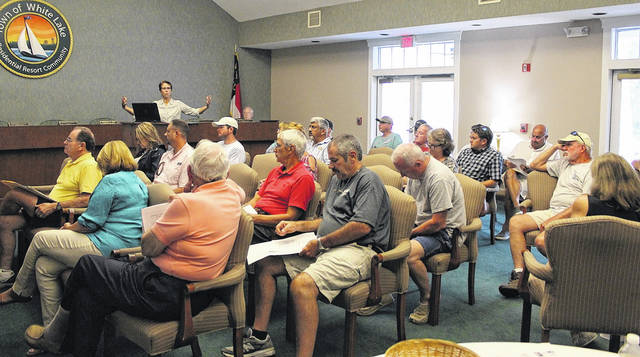WHITE LAKE — Berry farmers are not doing damage, and aquifers won’t be the answer to bringing more water.
At a meeting Thursday for planning management of White Lake, those were the opinions of Jim Perry, a special projects planner with the Lumber River Council of Governments. Perry made clear he’s not a scientist, but he has worked with many who study the land and how water interacts with it.
He joined Dr. Diane Lauritsen of Limnosciences/Envirochem in the presentation portion of a meeting that lasted about two hours. Roughly three dozen people attended, including the mayor, three commissioners and one challenger to the commission in the November municipal election.
Also present were just a handful of the many speakers to come before the board in the last several months asking for answers to the health of White Lake.
What Perry and Lauritsen sought to do was move the conversation toward planned management. This was the second in a series of workshops.
At various points, a number of questions labeled as rumors were presented and answered. Information was also shared regarding how water on the surficial aquifer that includes the lake interacts, including with nearby bodies of water.
Lauritsen’s PowerPoint presentation included a history lesson that showed low water levels and health issues with the lake dating back more than a quarter century. The Bladen Journal and Fayetteville Observer sample newspaper clippings on a table included headlines of “Grim White Lake Picture is Painted,” “The Lake: As Facilities Improve, Its Condition Declines,” “The Lake: Number, Size of Boats Can Contribute To Problems,” “Killing the lake they love,” “Concern Voiced For White Lake Water,” and “Swamps Important To Lake’s Welfare.”
Lauritsen reviewed actions taken in 2018, monitoring and sediment studies ongoing, possibilities for the future and the effect of hydrilla. Perry talked about grant-funded projects between the COG and the town toward storm water assessments and management.
With regard to the town’s wastewater collection system, Perry said, “There’s not a town in this state that doesn’t have this problem. Many were built in the 1930s, with what was then state of the art material.
“The town has been very aggressive, more so than most towns we work with, in dealing with this problem.”
He also gave the group detailed information on the aquifer system, presenting a mapping of them and significant wells from Moore County to the coast. The detail, offered from extensive study by Groundwater Management Associates, included the Upper Cape Fear Aquifer, Lower Cape Fear Aquifer, Black Creek Aquifer and the PeeDee Aquifer.
Perry explained there are portions of central and northeastern North Carolina that have pumped the aquifers into dangerously low levels. Southeastern North Carolina has been better managed, he said, and needed to continue.
Those aquifers would not be a supplier of water to White Lake; rather, a surficial aquifer does.
As for berry farmers, Perry said, “Their wells are in the Black Creek aquifer. Their pumping is not affecting the surficial aquifer, unless it’s a major well like Smithfield. They’re pumping from the Cape Fear.
“The other things they have, and most farms have, are irrigation ponds — not a retention pond. Those irrigation ponds are going to react the same way the lake is. Actually, they’re helping recharge the surficial aquifer if they’re upstream.”
He wouldn’t go 100 percent, but he was about as close as he could get in offering of the berry farmers, “I think it is correct in saying they’re probably not having an effect on the flow to the lake.”
Perry doesn’t believe White Lake is alone in having a surficial aquifer.
“I wouldn’t doubt that Jones Lake and some of the others have them too,” he said. “It’s a way that the lake is recharging.”
The group was asked for a show of hands to indicate concern for 16 various issues. Nearly all were significant to more than half of those attending.
“We’ve got to do things that are scientifically based,” Mayor Goldston Womble said at the close.
Lauritsen finished with a look at what a “natural” White Lake looks like. She noted the more it and its watershed are altered, the more difficult it is to retain the natural elements.
Management actions, such as last year’s alum treatment, that simulate natural processes are most likely to be successful. She also pointed out that some uses of the lake that can be harmful can be eliminated with little cost to implement.

The outlook for White Lake, per the headlines of the 1980s, was as bad or worse than 2019.

White Lake’s headlines from more than a quarter century ago indicate some of its problems are cyclical.

White Lake’s headlines from more than a quarter century ago indicate some of its problems are cyclical.

About three dozen people came out Thursday for a management workshop. Dr. Diane Lauritsen (rear) led the presentation.

